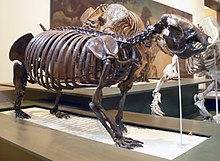| Megalocnidae Temporal range:
| |
|---|---|

| |
| Megalocnus rodens, an extinct Cuban megalocnid sloth (AMNH) | |
| Scientific classification | |
| Domain: | Eukaryota |
| Kingdom: | Animalia |
| Phylum: | Chordata |
| Class: | Mammalia |
| Order: | Pilosa |
| Suborder: | Folivora |
| Family: | †Megalocnidae White and MacPhee, 2001 |
| Genera | |
| Synonyms | |
|
Megalocnoidea Delsuc et al, 2019 | |
Megalocnidae is an extinct family (alternatively considered to be a superfamily as Megalocnoidea) of sloths, native to the islands of the Greater Antilles from the Early Oligocene to the Mid-Holocene. They are known from Cuba, Hispaniola and Puerto Rico, but are absent from Jamaica. While they were formerly placed in the Megalonychidae alongside two-toed sloths and ground sloths like Megalonyx, recent mitochondrial DNA and collagen sequencing studies place them as the earliest diverging group basal to all other sloths.[1][2] or as an outgroup to Megatherioidea.[3] They displayed significant diversity in body size and lifestyle, with Megalocnus being terrestrial and probably weighing several hundred kilograms, while Neocnus was likely arboreal and similar in weight to extant tree sloths, at less than 10 kilograms.[4]
- ^ Delsuc, F.; Kuch, M.; Gibb, G.C.; Karpinski, E.; Hackenberger, D.; Szpak, P.; Martínez, J.G.; Mead, J.I.; McDonald, H.G.; MacPhee, R.D.E.; Billet, G. (June 2019). "Ancient Mitogenomes Reveal the Evolutionary History and Biogeography of Sloths". Current Biology. 29 (12): 2031–2042.e6. Bibcode:2019CBio...29E2031D. doi:10.1016/j.cub.2019.05.043. hdl:11336/136908. PMID 31178321.
- ^ Presslee, S.; Slater, G.J.; Pujos, F.; Forasiepi, A.M.; Fischer, R.; Molloy, K.; Mackie, M.; Olsen, J.V.; Kramarz, A.; Taglioretti, M.; Scaglia, F. (July 2019). "Palaeoproteomics resolves sloth relationships". Nature Ecology & Evolution. 3 (7): 1121–1130. Bibcode:2019NatEE...3.1121P. doi:10.1038/s41559-019-0909-z. PMID 31171860. S2CID 174813630.
- ^ Tejada, Julia V; Antoine, Pierre-Olivier; Münch, Philippe; Billet, Guillaume; Hautier, Lionel; Delsuc, Frédéric; Condamine, Fabien L (2023-12-02). Wright, April (ed.). "Bayesian Total-Evidence Dating Revisits Sloth Phylogeny and Biogeography: A Cautionary Tale on Morphological Clock Analyses". Systematic Biology. 73 (1): 125–139. doi:10.1093/sysbio/syad069. ISSN 1063-5157. PMC 11129595. PMID 38041854.
- ^ Cite error: The named reference
Defler2019was invoked but never defined (see the help page).